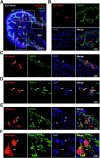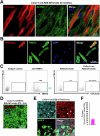Epiblast-derived CX3CR1+ progenitors generate cardiovascular cells during cardiogenesis
- PMID: 40551012
- PMCID: PMC12316875
- DOI: 10.1038/s44318-025-00488-z
Epiblast-derived CX3CR1+ progenitors generate cardiovascular cells during cardiogenesis
Abstract
CX3CR1+ cells generate tissue macrophages in the developing heart and play cardioprotective roles in response to ischemic injuries in the adult heart. However, the origin and fate of CX3CR1+ cells during cardiogenesis remain unclear. Here, we performed genetic lineage tracing of CX3CR1+ cells and their progeny (termed Cx3cr1 lineage cells) in the mouse and demonstrated that they emerge from a subset of epiblast cells at embryonic day E6.5 and contribute to the parietal endoderm cells at E7.0. At E8.0-9.5 of development, Cx3cr1 lineage cells produced cardiomyocytes and endothelial cells via both de novo differentiation and fusion with pre-existing cardiomyocytes or endothelial cells, respectively. Cx3cr1 lineage cells persisted in the adult heart, comprising ~13% of cardiomyocytes and ~31% of endothelial cells. Additionally, CX3CR1+ cells differentiated from mouse embryonic stem cells generated cardiomyocytes, endothelial cells, and macrophages in vitro, ex vivo, and in vivo. Single-cell RNA sequencing revealed that Cx3cr1+ cells represent an intermediate cell population transitioning from embryonic stem cells to mesoderm. Taken together, embryonic CX3CR1+ cells constitute a multipotent epiblast-derived progenitor population that contributes not only to the formation of macrophages, but also of cardiomyocytes and endothelial cells.
Keywords: CX3CR1; Cardiogenesis; Cardiomyocyte; Endothelial Cells; Genetic Lineage Tracing.
© 2025. The Author(s).
Conflict of interest statement
Disclosure and competing interests statement. The authors declare that they have no competing interests or relevant financial or non-financial disclosures.
Figures







Similar articles
-
Donor embryonic stem cells displace host cells of 8-cell-stage chimeras to the extra-embryonic lineages by spatial crowding and FGF4 signalling.Development. 2025 Jun 15;152(12):dev204518. doi: 10.1242/dev.204518. Epub 2025 Jun 24. Development. 2025. PMID: 40446208 Free PMC article.
-
Lineage contribution of the mesendoderm progenitors in the gastrulating mouse embryo.Dev Cell. 2025 Jul 21;60(14):1991-2006.e9. doi: 10.1016/j.devcel.2025.02.015. Epub 2025 Mar 24. Dev Cell. 2025. PMID: 40132585
-
HAND factors regulate cardiac lineage commitment and differentiation from human pluripotent stem cells.Stem Cell Res Ther. 2024 Feb 5;15(1):31. doi: 10.1186/s13287-024-03649-9. Stem Cell Res Ther. 2024. PMID: 38317221 Free PMC article.
-
Stem cell insights into human trophoblast lineage differentiation.Hum Reprod Update. 2016 Dec;23(1):77-103. doi: 10.1093/humupd/dmw026. Epub 2016 Sep 2. Hum Reprod Update. 2016. PMID: 27591247
-
Stage-specific DNA methylation dynamics in mammalian heart development.Epigenomics. 2025 Apr;17(5):359-371. doi: 10.1080/17501911.2025.2467024. Epub 2025 Feb 21. Epigenomics. 2025. PMID: 39980349 Review.
References
-
- Arnold L, Perrin H, de Chanville CB, Saclier M, Hermand P, Poupel L, Guyon E, Licata F, Carpentier W, Vilar J, Mounier R, Chazaud B, Benhabiles N, Boissonnas A, Combadiere B, Combadiere C (2015) CX3CR1 deficiency promotes muscle repair and regeneration by enhancing macrophage ApoE production. Nat Commun 6:8972 - PMC - PubMed
MeSH terms
Substances
Grants and funding
LinkOut - more resources
Full Text Sources
Molecular Biology Databases

